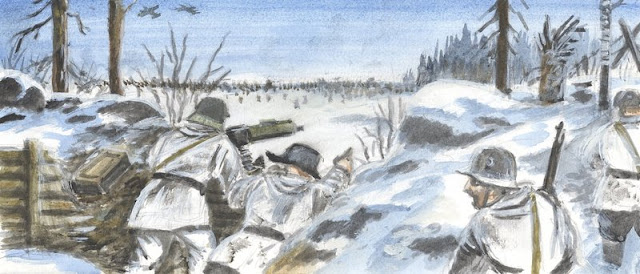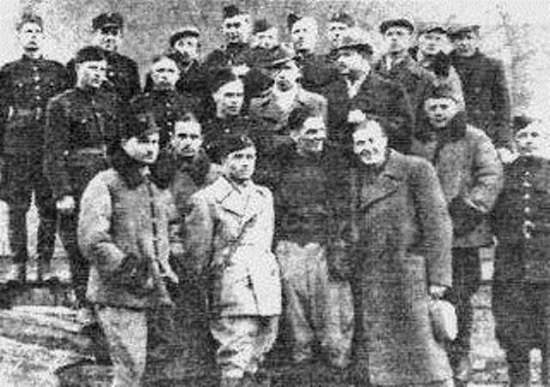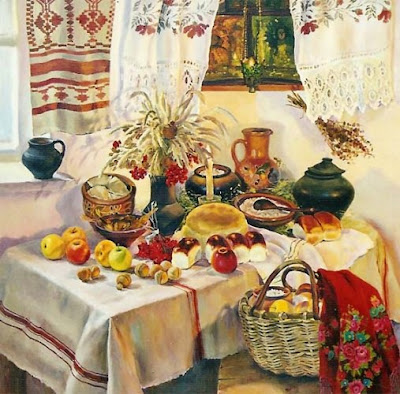THE FINNISH WINTER WAR EXPERIENCE AS A LESSON FOR CONTEMPORARY UKRAINE
Exactly 100 years ago a small Nordic country of Finland gained state independence. The experience of Finland is quite indicative for modern Ukraine. The assertion of the Finnish nation was due to the tragic events of the First World War (1914-1918) and the destruction of the Russian Empire (1917-1918). The problems of revolutionary events in the state of the Romanovs radically influenced the growth of national consciousness among the political elite of the Finns, led to the proclamation of Finland's independence in December 1917. However, from January to May 1918 the Finns was defending their liberty in battles with local and visiting Bolshevik gangs.
For Finland 1917 was a turning year, despite the rabid propaganda of connoisseurs of Karl Marx. There was a consolidation of all layers of the Finnish population in the name of gaining complete freedom and national sovereignty. The famous captain of the Kholodnyi Yar, Yuriy Horlis-Horskyi, in his article "Finlandia" said of the Finns' desire to be independent: "The threat posed by the Red Moscow automatically proved the Finns to political unity, there are political parties, democrats and nationalists, but the political struggle has disappeared and quarrels all united under one slogan: Finland and only Finland! Each in its own place working under this slogan and rejecting the side of the secondary."
The February revolution of 1917 in the once stable and repressive state of the Romanovs, stretching from the Pacific to the Baltic and Black Seas, led to important economic, social, and political changes on its territory. After the abdication of the last Tsar Nicholas II began the movement of many nations for the establishment of their own states. As a result of liberation movements, independence was proclaimed by Finland, Ukraine, Estonia, Belarus, Lithuania, Latvia, Georgia and Turkestan... An autonomous Ukrainian Central Rada was formed on the territory of Naddniprianshchyna, which subsequently developed into the government of an independent Ukrainian People's Republic. Ukrainians, descendants of ancient Rus’ vigilantes and Cossacks, fought valiantly for their national self-determination for whole four years. However, the bloody arm of the Bolshevik hangman sought to harvest, so the independence of the former provinces was seen as a historical mistake, which should be rooted out.
But the October overthrow the Finnish government, which at that time was personified by the already democratically constituted Parliament – Eduskunta and the Senate government, perceived as a signal of danger. Even that part of the Finnish political elite, which was interested in economic ties with the former Romanov state – with the "democratic states of Russia", now focused exclusively on Germany. The Finns wanted to enlist the military support of Emperor Wilhelm II in order not to allow the Bolsheviks to stick to the West. However, the government of the German Empire decided to stick to a wait-and-see attitude, limited only to the material supply of the armed forces of the newly-formed state, only formed from the ashes of the "Great War". In turn, following his national-political tactics, Vladimir Lenin was ready to formally recognize Finland's independence. He was afraid of actions that could be interpreted by his associates in Europe as a national oppression and, in his opinion, would hamper the development of the "world revolution".
After the overthrow of the Provisional Government by the Bolsheviks in Petrograd and several misunderstandings between the nationalists and the Social Democrats in Helsinki about who should have power in Finland – left or right, on 28th November 1917 the deputies of the Eduskunta assumed the supreme state power in the country of Suomi. The people's deputies authorized the Senate to draft a constitution for an independent state. On 4th December 1917 the draft of the new constitution was submitted to the Parliament of Finland for consideration, Senate chairman Pehr Evind Svinhufvud announced the manifesto "To the people of Finland", which later became known as the declaration of independence. This manifesto announced the intention to change the state system of Finland, and also contained an appeal "To the power of foreign states" with a request to recognize the sovereignty of the people of Finland: "The people of Russia, after the overthrow of tsarism, repeatedly made it clear that it gives the people of Finland the right to determine their future the basis of its centuries-old cultural development. The firm will of the Finnish people carried through the horrors of war and is based on the principle that no nation should be dependent on another without in the desire."
For Finland 1917 was a turning year, despite the rabid propaganda of connoisseurs of Karl Marx. There was a consolidation of all layers of the Finnish population in the name of gaining complete freedom and national sovereignty. The famous captain of the Kholodnyi Yar, Yuriy Horlis-Horskyi, in his article "Finlandia" said of the Finns' desire to be independent: "The threat posed by the Red Moscow automatically proved the Finns to political unity, there are political parties, democrats and nationalists, but the political struggle has disappeared and quarrels all united under one slogan: Finland and only Finland! Each in its own place working under this slogan and rejecting the side of the secondary."
The February revolution of 1917 in the once stable and repressive state of the Romanovs, stretching from the Pacific to the Baltic and Black Seas, led to important economic, social, and political changes on its territory. After the abdication of the last Tsar Nicholas II began the movement of many nations for the establishment of their own states. As a result of liberation movements, independence was proclaimed by Finland, Ukraine, Estonia, Belarus, Lithuania, Latvia, Georgia and Turkestan... An autonomous Ukrainian Central Rada was formed on the territory of Naddniprianshchyna, which subsequently developed into the government of an independent Ukrainian People's Republic. Ukrainians, descendants of ancient Rus’ vigilantes and Cossacks, fought valiantly for their national self-determination for whole four years. However, the bloody arm of the Bolshevik hangman sought to harvest, so the independence of the former provinces was seen as a historical mistake, which should be rooted out.
But the October overthrow the Finnish government, which at that time was personified by the already democratically constituted Parliament – Eduskunta and the Senate government, perceived as a signal of danger. Even that part of the Finnish political elite, which was interested in economic ties with the former Romanov state – with the "democratic states of Russia", now focused exclusively on Germany. The Finns wanted to enlist the military support of Emperor Wilhelm II in order not to allow the Bolsheviks to stick to the West. However, the government of the German Empire decided to stick to a wait-and-see attitude, limited only to the material supply of the armed forces of the newly-formed state, only formed from the ashes of the "Great War". In turn, following his national-political tactics, Vladimir Lenin was ready to formally recognize Finland's independence. He was afraid of actions that could be interpreted by his associates in Europe as a national oppression and, in his opinion, would hamper the development of the "world revolution".
After the overthrow of the Provisional Government by the Bolsheviks in Petrograd and several misunderstandings between the nationalists and the Social Democrats in Helsinki about who should have power in Finland – left or right, on 28th November 1917 the deputies of the Eduskunta assumed the supreme state power in the country of Suomi. The people's deputies authorized the Senate to draft a constitution for an independent state. On 4th December 1917 the draft of the new constitution was submitted to the Parliament of Finland for consideration, Senate chairman Pehr Evind Svinhufvud announced the manifesto "To the people of Finland", which later became known as the declaration of independence. This manifesto announced the intention to change the state system of Finland, and also contained an appeal "To the power of foreign states" with a request to recognize the sovereignty of the people of Finland: "The people of Russia, after the overthrow of tsarism, repeatedly made it clear that it gives the people of Finland the right to determine their future the basis of its centuries-old cultural development. The firm will of the Finnish people carried through the horrors of war and is based on the principle that no nation should be dependent on another without in the desire."
At the same time, the Senate presented to the deputies of Eduskunta a number of other draft laws designed to facilitate the implementation of the most urgent measures for reforming the future independent state of Finland before the new constitution comes into force, and Svinhufvud was declared prime minister and temporary supreme ruler of the country. And already on 6th December 1917 the manifesto was ratified by voting: 100 deputies are supported and 88 deputies are opposed. In the Senate there was no desire to recognize the Bolshevik government of Lenin, who came to power through armed insurrection. But it soon became clear that without this, diplomatic recognition of Finland by other countries is impossible. Therefore, Svinhufvud was forced to turn to the leader of the Bolsheviks to recognize the state independence of Suomi.
Meanwhile, former Finnish volunteer huntsmen, patriots and nationalists became the guardians of the proclaimed state independence of the young country of Finland, fought in the fields of the First World War in the ranks of the Wilhelm II army. In May 1917 the Finnish hunters formed the Active Committee in the center of Helsinki. Its members developed a plan for the military-political activities of the prototype organization of the volunteer army – the Civil Guard or Suojeluskunta, which was to operate throughout the country.
In December 1917, when Finland became independent, street riots broke out between local marxists and nationalists. Political encounters resumed, forcing the Senate and most of the deputies to move from Helsinki to the safer city of Vaasa on the banks of the Gulf of Bothnia. At this time, the radical-minded Social Democrats, along with other left-wing forces, organized detachments of the Red Guard. Armed Red Guards at the end of January 1918 proclaimed Finland a socialist workers' republic with the power of the Soviets, which in the near future had to join a large union of similar state entities under Russian Bolshevik rule.
The political elite of Finland led by Svinhufvud receiving financial support from Sweden, forms an independent national government in Vaasa. At the same time, the retired royal officer Carl Gustaf Emil Mannerheim was appointed to command the newly formed armed forces in order to prevent the spread of "red gangrene" to the whole of Finland. A civil war broke out, lasting 111 days, until 16th May 1918. This bitter conflict the Reds were unable to win, despite the considerable support of Lenin's Bolsheviks. After all, to the aid of Mannerheim came the Swedish volunteers and the regular German army in the form of the Baltic Sea Division.
Already in April 1919 the first constitution of the independent Finnish Republic was adopted, and was elected the first president of Suomi. It was Swedish Finn from Suomussalmi – Kaarlo Juho Ståhlberg. The disputed issues with the Bolsheviks were settled thanks to the peace agreement concluded in the Estonian city of Tartu in October 1920. However, the eastern bear will try twice again to capture small Finland in the bloody wars for the redistribution of Europe (the Winter War of 1939-1940 and the Continuation War of 1941 1944), but it will not reach its goal. The country of Suomi, despite significant human and territorial losses, will stand and retain its independence!
Meanwhile, former Finnish volunteer huntsmen, patriots and nationalists became the guardians of the proclaimed state independence of the young country of Finland, fought in the fields of the First World War in the ranks of the Wilhelm II army. In May 1917 the Finnish hunters formed the Active Committee in the center of Helsinki. Its members developed a plan for the military-political activities of the prototype organization of the volunteer army – the Civil Guard or Suojeluskunta, which was to operate throughout the country.
In December 1917, when Finland became independent, street riots broke out between local marxists and nationalists. Political encounters resumed, forcing the Senate and most of the deputies to move from Helsinki to the safer city of Vaasa on the banks of the Gulf of Bothnia. At this time, the radical-minded Social Democrats, along with other left-wing forces, organized detachments of the Red Guard. Armed Red Guards at the end of January 1918 proclaimed Finland a socialist workers' republic with the power of the Soviets, which in the near future had to join a large union of similar state entities under Russian Bolshevik rule.
The political elite of Finland led by Svinhufvud receiving financial support from Sweden, forms an independent national government in Vaasa. At the same time, the retired royal officer Carl Gustaf Emil Mannerheim was appointed to command the newly formed armed forces in order to prevent the spread of "red gangrene" to the whole of Finland. A civil war broke out, lasting 111 days, until 16th May 1918. This bitter conflict the Reds were unable to win, despite the considerable support of Lenin's Bolsheviks. After all, to the aid of Mannerheim came the Swedish volunteers and the regular German army in the form of the Baltic Sea Division.
Already in April 1919 the first constitution of the independent Finnish Republic was adopted, and was elected the first president of Suomi. It was Swedish Finn from Suomussalmi – Kaarlo Juho Ståhlberg. The disputed issues with the Bolsheviks were settled thanks to the peace agreement concluded in the Estonian city of Tartu in October 1920. However, the eastern bear will try twice again to capture small Finland in the bloody wars for the redistribution of Europe (the Winter War of 1939-1940 and the Continuation War of 1941 1944), but it will not reach its goal. The country of Suomi, despite significant human and territorial losses, will stand and retain its independence!
In contrast to
Ukraine, where the nation and the formation of national consciousness has been
counted for more than one century, and also led to the receipt of short-term
independence during 1917-1921, in Finland the same process lasted only 30-50
years. But this was enough for the Finns to win and retain such a welcome
independence with weapons in hand and with the national idea in their heart.
Ukrainian power under the guidance of a talented historian, but the failed
policy Mykhailo Hrushevskyi and the socialist Volodymyr Vynnychenko did not
care about the nation. They did not want to protect Ukrainian sovereign with an
army, and therefore they lost their own state to the bearers of anti-Ukrainian
ideology...
We remember the events of 100 years ago with the goal of not repeating
the mistakes of the past, finally stopping the chain of failures that
our various statesmen were inspired by different boasters-agitators from the
East and the West as a kind of standard. State independence and national
freedom should become today not just words, but symbols for sacrificial life
for all problems. Therefore, if there were not, but the story nevertheless put
everything in its place – free and independent Ukraine and Finland are existing.
by Denis KOVALYOV, source the Pravy Sektor






Коментарі
Дописати коментар